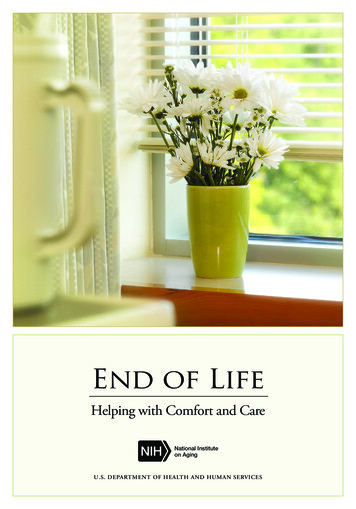
Transcription
End of LifeHelping with Comfort and CareNational Instituteon AgingU.S. DEPARTMENT OF HEALTH AND HUMAN SERVICES
National Institute on AgingOffice of Communications and Public LiaisonBethesda, MD 20892-2292www.nia.nih.gov
End of LifeHelping with Comfort and Care3Introduction5Providing Comfort at the End of Life19Care Options at the End of Life34Dementia at the End of Life39Understanding Healthcare Decisions51What Happens When Someone Dies54Things to Do after Someone Dies58Getting Help for Your Grief61Planning for End-of-Life Care Decisions68Closing Thoughts69Resources
Empty-handed I entered the world,Barefoot I leave it.My coming, my goingTwo simple happeningsThat got entangled.— Kozan Ichikyo (d. 1360)2
I n t r od u c t i onAt the end of life, each story is different. Death comes suddenly, or aperson lingers, gradually fading. For some older people, the body weakenswhile the mind stays alert. Others remain physically strong, but cognitivelosses take a huge toll. Although everyone dies, each loss is personally feltby those close to the one who has died.End-of-life care is the term used to describe the support and medical caregiven during the time surrounding death. Such care does not happenonly in the moments before breathing ceases and the heart stops beating.Older people often live with one or more chronic illnesses and need a lotof care for days, weeks, and even months before death.The goal of End of Life: Helping with Comfort and Care is to provideguidance and help in understanding the unfamiliar territory of death.This information is based on research, such as that supported by theNational Institute on Aging (NIA), along with other parts of the NationalInstitutes of Health. It also includes suggestions from healthcare providerswith expertise in helping individuals and families through this difficult3
INTRODUCTIONtime. Most of the stories included are examples of common experiencesat the end of life.When a doctor says something like, “I’m afraid the news is not good.There are no other treatments for us to try. I’m sorry,” it may close thedoor to the possibility of a cure, but it does not end the need for medicalsupport. Nor does it end the involvement of family and friends.There are many ways to provide care for an older person who is dying.Such care often involves a team. If you are reading this, then you mightbe part of such a team.End of Life: Helping with Comfort and Care provides an overview ofissues often faced by people caring for someone nearing the end of life.The information provided here does not replace the personal and specificadvice of the doctor or other experts, but it can help you make sense ofwhat is happening and give you a framework for making care decisions.A sampling of resources related to end-of-life care are provided if you arelooking for more information.4
Providing Comfortat the End of LifeComfort care is an essential part of medical care at the end of life. It iscare that helps or soothes a person who is dying. The goals are to preventor relieve suffering as much as possible and to improve quality of lifewhile respecting the dying person’s wishes.You are probably reading this because someone close to you is dying. Youwonder what will happen. You want to know how to give comfort, what tosay, what to do. You might like to know how to make dying easier—howto help ensure a peaceful death, with treatment consistent with the dyingperson’s wishes.A peaceful death might mean something different to you than to someoneelse. Your sister might want to know when death is near so she can have a fewlast words with the people she loves and take care of personal matters. Yourhusband might want to die quickly and not linger. Perhaps your mother hassaid she would like to be at home when she dies, while your father wants to bein a hospital where he can receive treatment for his illness until the very end.Some people want to be surrounded by family and friends; others wantto be alone. Of course, often one doesn’t get to choose. But, avoiding5
P ROV I D I N G C O M F O RTsuffering, having your end-of-life wishes followed, and being treatedwith respect while dying are common hopes.Generally speaking, people who are dying need care in four areas—physical comfort, mental and emotional needs, spiritual issues, andpractical tasks. Their families need support as well. In this section,you will find a number of ways you can help someone who is dying.Always remember to check with the healthcare team to make sure thesesuggestions are appropriate for your situation.Comfort needs near the end of life: Physical ComfortMental and Emotional Needs Spiritual Issues Practical TasksPhysical ComfortThere are ways to make a person who is dying more comfortable.Discomfort can come from a variety of problems. For each, there arethings you or a healthcare provider can do, depending on the cause. Forexample, a dying person can be uncomfortable because of: Breathing problems Skin irritation Digestive problems6
E N D O F L I F E : H E L P I N G W I T H C O M F O RT A N D C A R E Temperature sensitivity FatiguePain. Watching someone you love die is hard enough, but thinkingthat person is also in pain makes it worse. Not everyone who is dyingexperiences pain, but there are things you can do to help someone whodoes. Experts believe that care for someone who is dying should focus onrelieving pain without worrying about possible long-term problems ofdrug dependence or abuse.Don’t be afraid of giving as much pain medicine as is prescribed by thedoctor. Pain is easier to prevent than to relieve, and severe pain is hardto manage. Try to make sure that the level of pain does not get aheadof pain-relieving medicines. Tell the doctor or nurse if the pain is notcontrolled. Medicines can be increased or changed. If this doesn’t help,then ask for consultation with a palliative medical specialist who hasexperience in pain management for seriously ill patients (see PalliativeCare, page 20).What about morphine and other painkillers?Morphine is an opiate, a strong drug used to treat serious pain.Sometimes, morphine is also given to ease the feeling ofshortness of breath. Pain medication can make people confusedor drowsy. You might have heard that giving morphine leadsto a quicker death. Is that true? Most experts think this isunlikely, especially if increasing the dose is done carefully.Successfully reducing pain and/or concerns about breathingcan provide needed comfort to someone who is close to dying.7
P ROV I D I N G C O M F O RTStruggling with severe pain can be draining. It can make it hard for familiesto be together in a meaningful way. Pain can affect mood—being in pain canmake someone seem angry or short-tempered. Although understandable,irritability resulting from pain might make it hard to talk, hard to sharethoughts and feelings.Breathing problems. Shortness of breath or the feeling that breathingis difficult is a common experience at the end of life. The doctor mightcall this dyspnea (disp-NEE-uh). Worrying about the next breath canmake it hard for important conversations or connections. Try raisingthe head of the bed, opening a window, using a humidifier, or havinga fan circulating air in the room. Sometimes, morphine or other painmedications can help relieve the sense of breathlessness.People very near death might have noisy breathing, sometimes calleda death rattle. This is caused by fluids collecting in the throat or bythe throat muscles relaxing. It might help to try turning the person torest on one side. There is also medicine that can be prescribed that mayhelp clear this up. Not all noisy breathing is a death rattle. It may helpto know that this noisy breathing is usually not upsetting to the dyingperson, even if it is to family and friends.Skin irritation. Skin problems can be very uncomfortable. With age,skin naturally becomes drier and more fragile, so it is important to takeextra care with an older person’s skin. Gently applying alcohol-free lotioncan relieve dry skin and be soothing.Dryness on parts of the face, such as the lips and eyes, can be a commoncause of discomfort near death. A lip balm could keep this from gettingworse. A damp cloth placed over closed eyes might relieve dryness. If the8
E N D O F L I F E : H E L P I N G W I T H C O M F O RT A N D C A R Einside of the mouth seems dry, giving ice chips (if the person is conscious) orwiping the inside of the mouth with a damp cloth, cotton ball, or speciallytreated swab might help.Sitting or lying in one position puts constant pressure on sensitive skin,which can lead to painful bed sores (sometimes called pressure ulcers).When a bed sore first forms, the skin gets discolored or darker. Watchcarefully for these discolored spots, especially on the heels, hips, lowerback, and back of the head.Turning the person from side to back and to the other side every fewhours may help prevent bed sores. Try putting a foam pad under an arealike a heel or elbow to raise it off the bed and reduce pressure. Ask if aspecial mattress or chair cushion might also help. Keeping the skin cleanand moisturized is always important.Digestive problems. Nausea, vomiting, constipation, and loss of appetiteare common issues at the end of life. The causes and treatments for thesesymptoms are varied, so talk to a doctor or nurse right away. There aremedicines that can control nausea or vomiting or relieve constipation, acommon side effect of strong pain medications.If someone near death wants to eat but is too tired or weak, you canhelp with feeding. To address loss of appetite, try gently offering favoritefoods in small amounts. Or, try serving frequent, smaller meals ratherthan three big ones.You don’t have to force a person to eat. Going without food and/or wateris generally not painful, and eating can add to discomfort. Losing one’sappetite is a common and normal part of dying. Swallowing may also be9
P ROV I D I N G C O M F O RTa problem, especially for people with dementia. A conscious decision togive up food can be part of a person’s acceptance that death is near.Temperature sensitivity. People who are dying may not be able to tellyou that they are too hot or too cold, so watch for clues. For example,someone who is too warm might repeatedly try to remove a blanket. Youcan take off the blanket and try a cool cloth on his or her head.If a person is hunching his or her shoulders, pulling the covers up, oreven shivering—those could be signs of cold. Make sure there is no draft,raise the heat, and add another blanket. Avoid electric blankets becausethey can get too hot.Fatigue. It is common for people nearing the end of life to feel tired andhave little or no energy. Keep activities simple. For example, a bedsidecommode can be used instead of walking to the bathroom. A showerstool can save a person’s energy, as can switching to sponging off in bed.Meena’s StoryAt 80, Meena had been in a nursing home for 2 years after a stroke, whenher health declined, and she was no longer able to communicate her wishes.Meena’s physician, Dr. Torres, told her family she was dying. She said thatmedical tests, physical therapy, and intravenous treatments were no longerreally needed and should be stopped because they might be causing Meenadiscomfort. Dr. Torres also said that checking vital signs (pulse, bloodpressure, temperature, and breathing rate) was interrupting her rest andwould no longer be done regularly.10
E N D O F L I F E : H E L P I N G W I T H C O M F O RT A N D C A R EThen, Meena developed pneumonia. Her family asked about moving herto the hospital. Dr. Torres explained that Meena could get the same care inthe familiar surroundings of her nursing home. Besides, the doctor said, amove could disturb and confuse her. The family agreed to leave Meena inthe nursing home, and she died 2 days later surrounded by those close to her.Experts suggest that moving someone to a different place, like a hospital, closeto the time of death, should be avoided if possible.Mental and Emotional NeedsComplete end-of-life care also includes helping the dying person managemental and emotional distress. Someone who is alert near the end of lifemight understandably feel depressed or anxious. It is important to treatemotional pain and suffering. Encouraging conversations about feelingsmight help. You might want to contact a counselor, possibly one familiarwith end-of-life issues. If the depression or anxiety is severe, medicinemay help.A dying person may also have some specific fears and concerns. He or shemay fear the unknown or worry about those left behind. Some peopleare afraid of being alone at the very end. This feeling can be made worseby the understandable reactions of family, friends, and even the medicalteam. For example, when family and friends do not know how to helpor what to say, sometimes they stop visiting. Or, someone who is alreadybeginning to grieve may withdraw.Doctors may feel helpless because they can’t cure their patient. Someseem to avoid a dying patient. This can add to a dying person’s sense11
P ROV I D I N G C O M F O RTof isolation. If this is happening, discuss your concerns with the family,friends, or the doctor.The simple act of physical contact—holding hands, a touch, or a gentlemassage—can make a person feel connected to those he or she loves. Itcan be very soothing. Warm your hands by rubbing them together orrunning them under warm water.Try to set a comforting mood. Remember that listening and beingpresent can make a difference. For example, Gordon loved a party, so itwas natural for him to want to be around family and friends when hewas dying. Ellen always liked spending quiet moments with one or twopeople at a time, so she was most comfortable with just a few visitors.Some experts suggest that when death is very near, music at a low volumeand soft lighting are soothing. In fact, near the end of life, music therapymight improve mood, help with relaxation, and lessen pain. Listeningto music might also evoke memories those present can share. Forsome people, keeping distracting noises like televisions and radios to aminimum is important.Often, just being present with a dying person is enough. It may not benecessary to fill the time with talking or activity. Your quiet presence canbe a simple and profound gift for a dying family member or friend.Spiritual IssuesPeople nearing the end of life may have spiritual needs as important astheir physical concerns. Spiritual needs include finding meaning in one’slife and ending disagreements with others, if possible. The dying person12
E N D O F L I F E : H E L P I N G W I T H C O M F O RT A N D C A R Emight find peace by resolving unsettled issues with friends or family.Visits from a social worker or a counselor may also help.Many people find solace in their faith. Others may struggle with theirfaith or spiritual beliefs. Praying, talking with someone from one’s religiouscommunity (such as a minister, priest, rabbi, or imam), reading religioustexts, or listening to religious music may bring comfort.Family and friends can talk to the dying person about the importanceof their relationship. For example, adult children can share how theirfather has influenced the course of their lives. Grandchildren can let theirgrandfather know how much he has meant to them. Friends can relatehow they value years of support and companionship. Family and friendswho can’t be present could send a recording of what they would like tosay or a letter to be read out loud.Sharing memories of good times is another way some people find peace neardeath. This can be comforting for everyone. Some doctors think it is possiblethat even if a patient is unconscious, he or she might still be able to hear. It isprobably never too late to say how you feel or to talk about fond memories.Always talk to, not about, the person who is dying. When you come intothe room, it is a good idea to identify yourself, saying something like, “Hi,Juan. It’s Mary, and I’ve come to see you.” Another good idea is to havesomeone write down some of the things said at this time—both by andto the person who is dying. In time, these words might serve as a sourceof comfort to family and friends. People who are looking for ways to helpmay welcome the chance to aid the family by writing down what is said.13
P ROV I D I N G C O M F O RTThere may come a time when a dying person who has been confusedsuddenly seems clear-thinking. Take advantage of these moments, butunderstand that they might be only temporary, not necessarily a signhe or she is getting better. Sometimes, a dying person may appear tosee or talk to someone who is not there. Try to resist the temptation tointerrupt or say they are imagining things. Give the dying person thespace to experience their own reality.Practical TasksMany practical jobs need to be done at the end of life—both to relievethe person who is dying and to support the caregiver. Everyday tasks canbe a source of worry for someone who is dying, and they can overwhelma caregiver. Taking over small daily chores around the house—such aspicking up the mail or newspaper, writing down phone messages, doing aload of laundry, feeding the family pet, taking children to soccer practice,or picking up medicine from the pharmacy—can provide a much-neededbreak for caregivers.A person who is dying might be worried about who will take care ofthings when he or she is gone. Offering reassurance—“I’ll make sureyour African violets are watered,” “Jessica has promised to take care ofBandit,” “Dad, we want Mom to live with us from now on”—mightprovide a measure of peace. Reminding the dying person that his or herpersonal affairs are in good hands can also bring comfort.Everyone may be asking the family, “What can I do for you?” It helpsto make a specific offer. Say to the family, “Let me help with . . . ” andsuggest something like bringing meals for the caregivers, paying bills,14
E N D O F L I F E : H E L P I N G W I T H C O M F O RT A N D C A R Ewalking the dog, or babysitting. If you’re not sure what to offer, talk tosomeone who has been through a similar situation. Find out what kindof help was useful.If you want to help but can’t get away from your own home, you couldschedule other friends or family to help with small jobs or to bring inmeals. This can allow the immediate family to give their full attention tothe person who is dying.If you are the primary caregiver, ask for help when you need it andaccept help when it’s offered. Don’t hesitate to suggest a specific task tosomeone who offers to help. Friends and family are probably anxious todo something for you and/or the person who is dying, but they may bereluctant to repeatedly offer when you are so busy.Keeping close friends and family informed can feel overwhelming.Setting up an outgoing voicemail message, a blog, an email list, a privateFacebook page, or even a phone tree can reduce the number of callsyou have to make. Some families create a blog or website to share news,thoughts, and wishes. See To Learn More about Comfort Care, page 17,for organizations that make setting up such webpages easy and secure.Or, you can assign a close family member or friend to make the updatesfor you. These can all help reduce the emotional burden of answeringfrequent questions.15
P ROV I D I N G C O M F O RTQuestions to Ask about Providing ComfortFamily and friends can provide comfort and ease to someone nearing theend of life. Here are some questions to help you learn more.Ask the doctor in charge: Since there is no cure, what will happen next? Why are you suggesting this test or treatment? Will the treatment bring physical comfort? Will the treatment speed up or slow down the dying process? What can we expect to happen in the coming days or weeks?Ask the caregiver: How are you doing? Do you need someone to talk with? Would you like to go out for an hour or two? I could stay herewhile you are away. Who has offered to help you? Do you want me to work with themto coordinate our efforts? Can I help, maybe . . . walk the dog, answer the phone, go to the drugstore or the grocery store, or watch the children (for example) . . .for you?16
E N D O F L I F E : H E L P I N G W I T H C O M F O RT A N D C A R ETo Learn More about Comfort CareSome resources to help you learn more about comfort care:American Academy of Pain Medicinewww.painmed.org 1-847-375-4731 info@painmed.org (email)American Music Therapy Associationwww.musictherapy.org 1-301-589-3300info@musictherapy.org (email)CaringBridgewww.CaringBridge.orgCaringInfo (National Hospice and Palliative Care Organization)www.caringinfo.org 1-800-658-8898 (toll-free)caringinfo@nhpco.org (email)Hospice and Palliative Nurses Associationwww.hpna.org 1-412-787-9301 hpna@hpna.org (email)National Alliance for Caregivingwww.caregiving.org/resources 1-301-718-8444info@caregiving.org (email)PostHopewww.posthope.orgWhat Matters Nowwww.whatmattersnow.org17
Death does not sound a trumpet.— African proverb18
C a r e Op t i on sat the End of LifeDecades ago, most people died at home, but medical advances havechanged that. Today, most Americans are in hospitals or nursing homesat the end of their lives. Some people enter the hospital to get treated foran illness. Some may already be living in a nursing home. Increasingly,people are choosing hospice care at the end of life. Hospice can beprovided in any setting—home, nursing home, assisted living facility,or inpatient hospital (see Hospice, page 22).There is no right place to die. And, of course, where we die is notalways something we get to decide. But, if given the choice, each personand/or his or her family should consider which type of care makes themost sense, where that kind of care can be provided, whether family andfriends are available to help, and how they will pay for it. In this section,we explain some of the care options available to people at the end of life.11 99
CARE OPTIONSPalliative CareDoctors can provide treatment to seriously ill patients in the hopes of acure for as long as possible. These patients may also receive medical carefor their symptoms, or palliative care, along with curative treatment.Who can benefit from palliative care?Palliative care is a resource for anyone living with a seriousillness, such as heart failure, chronic obstructive pulmonarydisease, cancer, dementia, Parkinson’s disease, and manyothers. Palliative care can be helpful at any stage of illnessand is best provided from the point of diagnosis.In addition to improving quality of life and helping withsymptoms, palliative care can help patients understandtheir choices for medical treatment. The organized servicesavailable through palliative care may be helpful to any olderperson having a lot of general discomfort and disability verylate in life. Palliative care can be provided along with curativetreatment and does not depend on prognosis.A palliative care consultation team is a multidisciplinary team thatworks with the patient, family, and the patient’s other doctors to providemedical, social, emotional, and practical support. The team is made ofpalliative care specialist doctors and nurses, and includes others such associal workers, nutritionists, and chaplains.2200
E N D O F L I F E : H E L P I N G W I T H C O M F O RT A N D C A R EPalliative care can be provided in hospitals, nursing homes, outpatientpalliative care clinics and certain other specialized clinics, or at home.Medicare, Medicaid, and insurance policies may cover palliative care.Veterans may be eligible for palliative care through the Department ofVeterans Affairs. Private health insurance might pay for some services.Health insurance providers can answer questions about what they willcover. Check to see if insurance will cover your particular situation.Adriana’s StoryAdriana developed anemia while she was being treated for breast cancer. Apalliative care specialist suggested she get a blood transfusion to manage theanemia and relieve some of the fatigue she was experiencing. Controlling hersymptoms helped Adriana to continue her curative chemotherapy treatment.Treating her anemia is part of palliative care.In palliative care, you do not have to give up treatment that might curea serious illness. Palliative care can be provided along with curativetreatment and may begin at the time of diagnosis. Over time, if thedoctor or the palliative care team believes ongoing treatment is nolonger helping, there are two possibilities. Palliative care could transitionto hospice care if the doctor believes the person is likely to die within6 months (see What does the hospice 6-month requirement mean?, page 26,for more about this timeframe). Or, the palliative care team couldcontinue to help with increasing emphasis on comfort care.2211
CARE OPTIONSHospiceTom’s StoryTom, who retired from the U.S. Air Force, was diagnosed with lung cancer atage 70. As his disease progressed and breathing became more difficult, he wantedto explore experimental treatments to slow the disease. Through the palliativecare provided by the Veterans Health Administration, Tom got treatment forhis disease and was able to receive the care and emotional support he needed tocope with his health problems. The palliative care program also helped arrangefor assistance around the house and other support for Tom’s wife, making iteasier for her to care for him at home. When the experimental treatments wereno longer helping, Tom enrolled in hospice. He died comfortably at home3 months later.At some point, it may not be possible to cure a serious illness, or a patientmay choose not to undergo certain treatments. Hospice is designed forthis situation. The patient beginning hospice care understands that hisor her illness is not responding to medical attempts to cure it or to slowthe disease’s progress.Like palliative care, hospice provides comprehensive comfort care as wellas support for the family, but, in hospice, attempts to cure the person’sillness are stopped. Hospice is provided for a person with a terminalillness whose doctor believes he or she has 6 months or less to live if theillness runs its natural course.Hospice is an approach to care, so it is not tied to a specific place. It canbe offered in two types of settings—at home or in a facility such as anursing home, hospital, or even in a separate hospice center.2222
E N D O F L I F E : H E L P I N G W I T H C O M F O RT A N D C A R EHospice care brings together a team of people with special skills—amongthem nurses, doctors, social workers, spiritual advisors, and trainedvolunteers. Everyone works together with the person who is dying, thecaregiver, and/or the family to provide the medical, emotional, andspiritual support needed.A member of the hospice team visits regularly, and someone is alwaysavailable by phone—24 hours a day, 7 days a week. Hospice may becovered by Medicare and other insurance companies; check to see ifinsurance will cover your particular situation.Dolores’ StoryChoosing hospice does not have to be a permanent decision. For example,Dolores was 82 when she learned that her kidneys were failing. She thoughtthat she had lived a long, good life and didn’t want to go through dialysis, soDolores began hospice care. A week later, she learned that her granddaughterwas pregnant. After talking with her husband, Dolores changed her mindabout using hospice care and left to begin dialysis, hoping to one day hold herfirst great-grandchild. Shortly after the baby was born, the doctors said Dolores’blood pressure was too low. At that point, she decided to re-enroll in hospice.It is important to remember that stopping treatment aimed at curingan illness does not mean discontinuing all treatment. A good example isan older person with cancer. If the doctor determines that the cancer isnot responding to chemotherapy and the patient chooses to enter intohospice care, then the chemotherapy will stop. Other medical care maycontinue as long as it is helpful. For example, if the person has highblood pressure, he or she will still get medicine for that.2233
C O M F O R T CCAARREE ATO P T IHOENESN D O F L I F ESome Differences between Palliative Care and HospicePALLIATIVE CAREHOSPICEWho can betreated?Anyone with a seriousillness at any stage oftheir diseaseAnyone with a seriousillness whom doctorsthink has only a shorttime to live, often lessthan 6 monthsWill my symptomsbe relieved?Yes, as much aspossibleYes, as much aspossibleCan I continueto receive treat ments to cure myillness?Yes, if you wishNo, only symptomrelief will be providedWill Medicarepay?It depends on yourbenefits andtreatment planYes, it pays all hospicechargesDoes privateinsurance pay?It depends on the planIt depends on the planHow long will I becared for?This depends on whatcare you need andyour insurance planAs long as you meetthe hospice’s criteriaof an illness with a lifeexpectancy of months,not yearsWhere will Ireceive this care? HomeAssisted living facilityNursing homeHospital HomeAssisted living facilityNursing homeHospice facilityHospitalCopyright National Hospice and Palliative Care Organization. All rights reserved.Reproduction and distribution by an organization or organized group without thewritten permission of the National Hospice and Palliative Care Organization areexpressly forbidden.24
E N D O F L I F E : H E L P I N G W I T H C O M F O RT A N D C A R EAlthough hospice provides a lot of support, the day-to-day care of aperson dying at home is provided by family and friends. The hospiceteam coaches family members on how to care for the dying person andeven provides respite care when caregivers need a break. Respite care canbe for as short as a few hours or for as long as several weeks.Annie and Maria’s StoryEighty-year-old Annie had advanced metastatic melanoma and asked forhelp through a hospice program so she could
Skin irritation. Skin problems can be very uncomfortable. With age, skin naturally becomes drier and more fragile, so it is important to take extra care with an older person’s skin. Gently applying alcohol-free lotion can relieve dry skin and be soothing. Dryness on part











